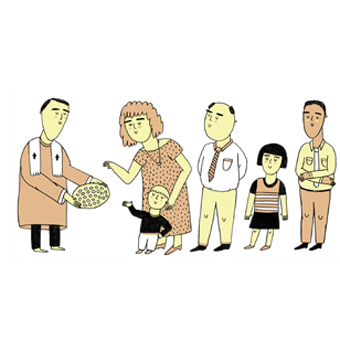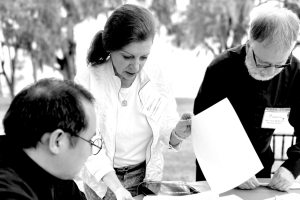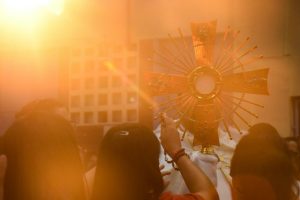Challenges and rewards abound in super-sized parishes.
Flip, flip, flip, flip!
Some 25 years later Maureen Regele laughs and says she’ll always remember the sound of 200 theater seats popping up and down during Mass. Back then her parish, St. Matthew in Charlotte, North Carolina, held weekly worship services in a small, dimly lit movie theater, which is all that was needed to serve the small group of Catholics living in the area at the time.
“There were very few Catholics when we moved here 25 years ago,” recalls Regele, a 52-year-old real estate broker who was among the first parishioners when St. Matthew was established in 1986. “We were kind of the oddity.”
The city’s population has exploded since then, growing from about 395,000 in 1990 to more than 705,000 today, and many of the area’s new inhabitants are Catholic. That’s led to an even more staggering rate of growth for St. Matthew. The community first moved to a newly constructed parish center in 1989, with parishioners setting up and taking down metal folding chairs for Masses held in a gymnasium. By 1996 the parish had a sprawling church building with amphitheater-style seating for up to 2,000 people, a choir pit, and a chapel.
Today the parish is home to more than 8,700 families—or nearly 30,000 individual parishioners—and holds eight weekend Masses, including one in the parish gym and one in a nearby Episcopal church to accommodate the massive crowds.
Regele realizes her beloved parish has come a long way from the movie theater that first housed its worship services. But because she has been there from the beginning, she says the expansion has always felt natural. “It’s still happening,” she says of the parish’s growth. “I don’t think we’ve had a non-growth month or decline since we began. Last year we averaged 62 new families a month.”
Super-size us
While its growth is extraordinary, St. Matthew is not the only parish in the United States that is bursting at the seams. Migration from the Northeast and Midwest to the Sun Belt, an influx of Catholic immigrants in the South and Southwest, and the closing or merging of smaller parishes have all contributed to the “super-sizing” of some parishes, according to “The Changing Face of U.S. Catholic Parishes,” a study conducted by the Center for Applied Research in the Apostolate (CARA) at Georgetown University. Released last July, the study is part of the Emerging Models of Pastoral Leadership project.
CARA reported that there had been a boom in creating new parishes in the Northeast and Midwest in the late 19th and early 20th centuries to meet the needs of the growing Catholic population in those areas, but those are not the regions with the largest Catholic populations today. The result has been parish closures or consolidations in those traditional Catholic strongholds, but there has yet to be a corresponding wave of new parish openings in other parts of the country.
“There are not a lot of dioceses building new parishes in areas where the Catholic population moved and is growing strongly,” wrote CARA researcher Mark Gray at the time of the study’s release. “I understand there are challenges to building a new parish including capital campaigns, planning commissions, architects, and construction companies to deal with. But a parish building boom will likely be needed in the U.S. Sun Belt in the 21st century.”
Without new parishes being created, the total number of U.S. parishes decreased from more than 19,000 in 2000 to fewer than 17,800 in 2010, about the same number of parishes that existed in 1965, the report notes. As a result, the average parish in 2010 contained 3,277 registered members, up 45 percent from the average of 2,260 parishioners in 2000.
As parishes continue to expand, pastors and staff are faced with new challenges in meeting the needs of their growing base of parishioners.
“It’s overwhelming at times,” says Father John Tizio, pastor of St. Mary Parish in Annapolis, Maryland. The parish is home to nearly 5,000 families, significantly more than the number of parishioners Tizio served in his previous parish assignment.
“At times I’m not sure what my focus needs to be on,” he says. “So many things come at me from so many directions.”
With more than 100 ministries in the parish, Tizio says that just finding the space for everyone to hold their meetings is a challenge. “A whole program is set up just to reserve space when they need to meet,” he says. “When you do something you have to think big. You don’t have that small country church thing when you just want to get together. Everything has to be scheduled. It’s kind of a drawback because you can’t do things spur of the moment. We also have people who want to try out different new ministries but we don’t have the space.”
Tizio also must allocate another scarce resource—his time. He credits the parish’s nine priests for doing what they can to help, be it presiding at a liturgy or taking his spot in the on-call chaplain rotation at the nearby Anne Arundel Medical Center, which lets him sleep uninterrupted through the night. That helps to take some of the pressure off being pastor to so many people.
“I love the community I’m living with. Sometimes the position, I don’t always love,” he says. “It’s a big responsibility. There are times I don’t sleep well at night because there are so many issues twirling around in my head. But it seems to be working out.”
Cast of thousands
With about 5,500 families to lead, Father John Dolan shares that experience as pastor at St. Rose Parish in Chula Vista, California, just south of San Diego. “We’re constantly on the go,” Dolan says. “There’s rarely a time when we have down time.”
Dolan says the help of his lay ministers, staff, and volunteers is critical to making St. Rose seem smaller. “It’s not a new secret,” he says. “It’s an age-old secret. Moses had to have multiple assistants to deal with the issues he had to deal with. I reach out to our groups and ministries and organizations and invite them to be evangelizers within the parish. I try to put it on the people of the parish who are involved already to get more people into their groups.”
One advantage of having such a large community is that there are more people available to become involved, and with larger budgets, bigger parishes can hire more paid staff members. “Sometimes the smaller the parish, the harder you work because your staff is smaller,” Dolan says. “I know pastors at small churches, and they work very hard. They’re out there cutting the weeds.”
Msgr. John McSweeney, the pastor of St. Matthew Parish in Charlotte, says that larger parishes also present the opportunity for new people with fresh ideas to take the lead. In the early 1980s McSweeney was pastor at a small parish of about 300 families, which he says was more difficult to administer from a pastor’s perspective.
“It’s a very small group of people who lead the activities,” he says of small parishes. But now he has a staff of 59 paid employees and 4,500 volunteers. “Here it’s super diverse. We try very hard not to have cliques who run the church.”
All are welcome
But having more people doesn’t automatically lead to increased involvement. The CARA report finds that as parishes grow, rates of attendance and financial giving per registered household tends to decrease. “There appears to be a size limit at which the parish community begins to become less active and less giving,” says Gray.
There may be a simple explanation for this phenomenon: In a larger parish, people are less likely to notice someone’s absence, and parishioners may feel like their individual contributions won’t be missed.
“It’s well known that attendance at the very large parishes declines because of a sense of anonymity,” says Franciscan Sister Katarina Schuth, who teaches social scientific study of religion at St. Paul Seminary in St. Paul, Minnesota. “At the rural parishes where I grew up, people knew if you didn’t show up for Mass—not because they were checking up on you, but because they were concerned about you.”
McSweeney says the secret to getting parishioners to overcome that feeling of anonymity is to put the parish’s resources into welcoming new members. “There were 25,000 people here at Christmas. That can scare some people,” he says. “The size can be intimidating to people when they first come here, but because of our ongoing sense of welcoming and reaching out to each other, it breaks down the barriers real fast.”
Longtime St. Matthew parishioner Regele is a member of the parish newcomers ministry, which runs a program designed to get new parishioners involved in parish life. More than 350 people have completed the program, which is modeled after the Susan Miller book After the Boxes Are Unpacked: Moving On After Moving In (Tyndale House).
“They really become a close-knit family,” Regele says of parishioners who complete the program. “We really try to get them involved in trying a small faith-sharing group of some kind because that’s where we’ve seen, over the years, that people really start feeling spiritually connected. People who come, and I hear from their comments, they speak of our church as very welcoming, and they’re energized.”
More than 60 volunteers at St. Matthew also take turns as official “greeters,” standing at the doors of the church to welcome people before each Mass. Volunteer Janet Garbison, who coordinates the greeters, says she thinks they “make a huge difference” in helping churchgoers feel welcome. She usually just quickly greets people, but some like to stop and chat. “You really start to connect with people,” Garbison says. “Not in a real intimate way, but you get to know them.”
She helped launch the program four years ago because she was hearing so many people talk about the parish’s large size. “In a parish this big, you can feel anonymous. People like to be recognized. I, for one, am thrilled that everyone is there, and I want them to know it.”
Garbison recalls how many St. Matthew parishioners noticed her absence during a recent vacation. “It just gives us an opening to connect with each other and learn more about each other. You feel like people care that you’re there when someone meets you at the door.”
Karen Wieman feels the large size of her parish, St. Ann in Coppell, Texas, makes for a vibrant, active community. The parish serves 8,900 registered households and offers a broad range of ministries that cater to the diverse needs and interests of the community. That was important to Wieman after her divorce six years ago.
“Even though it’s very large, we have so many ministries there, and if you get involved in them, it doesn’t seem so large,” says Wieman. “There are a lot of things going on, so no matter what floats your boat, you should be able to get involved in something.”
Because she works out of her home, her contact with others can be limited. So upon registering as a new member of St. Ann, she welcomed the chance to sign up for multiple ministries. She volunteered as a money counter and participated in several mission trips. She was asked to coordinate games at a carnival the parish organizes each September.
Wieman also caught on with the parish’s singles ministry, and is now president. The group of about 60 meets for dinner at restaurants and dances at St. Ann or other churches. They take on community service projects and sometimes attend Mass as a group. “I just feel like I’m a part of the parish family,” Wieman says.
Culture shifts
St. Ann is also among the parishes bolstered by a large Hispanic community, with two of its weekend Masses celebrated in Spanish and many ministries offered for Spanish-speaking parishioners. According to CARA, 29 percent of U.S. parishes now celebrate Mass in a language other than English, a 7 percent increase since 2000, and 37 percent of parishes host ethnic or cultural celebrations that parishioners have carried over from their native countries.
St. Raphael Parish in Springdale, Arkansas is among those to see a dramatic increase in parishioners due to immigration, as many have been drawn to the area by job opportunities at two large food processing plants and a wheel factory. The parish has grown from about 1,000 parishioners in 1983 to nearly 30,000 today.
When parishioner Lewis Germany moved to Springdale in 1993, there was one Saturday evening Mass and two on Sunday morning. Today those three services remain in English, but there are also two Spanish Masses on Saturday and a third on Sunday. Over the past five years, the parish has expanded its parking lot, added classroom space for more religious education classes, and renovated the parish hall. There is now talk of adding on to the church building.
“A lot of people haven’t adjusted to the change,” Germany says of the parish’s rapid growth. “It really has kind of taken a toll on the church with such large numbers.”
Mardonio Hernandez, a 62-year-old married father of three grown children, says it seems like St. Raphael’s congregation has doubled in size since he moved to Springdale from California in 1997. “I’m OK with it,” says Hernandez, a native of Mexico who has worked at a Tyson food processing plant for 16 years. “It’s getting [larger and larger], so we need to make the building bigger. When I go to church I see so many people standing on the side with no seats.”
But Germany, a member of the parish Knights of Columbus council, says St. Raphael is essentially two parishes—divided by those who speak English and those who speak Spanish, with the Spanish-speakers representing about 83 percent of the total congregation. Germany says his pastor, Father John O’Connell, has worked hard the past two years to bring the Hispanics and non-Hispanics together for parish events, such as an annual fundraiser to benefit a church building fund.
St. Raphael’s Knights of Columbus council recognizes the need to reach out to more Hispanics, Germany says, but thus far only about 10 of its 123 members are drawn from the Spanish-speaking community. The council is launching a new Spanish roundtable aimed at recruiting more members, though things have been progressing slowly thus far. “A lot of them don’t really know a whole lot about the Knights of Columbus and they’re kind of leery, but we’re trying to break through that barrier,” Germany says.
Germany says the recruiting drive seems to have more promise than past attempts because several bilingual members plan to begin making presentations after Spanish Masses.
Hernandez calls the recruitment effort “a good idea.” But if the effort fails, Hernandez says, it will simply be due to the fact that many Hispanic parishioners are not confident enough in their knowledge of English to join English-speaking parish groups.
“I think they feel better when they go to a Spanish Mass because they feel more comfortable,” Hernandez says. “We try to keep our culture from long ago of our fathers and grandparents. We try to learn more [English] but not as much as we need.”
Growth curve
For better or worse, the super-sized parish appears to be here to stay, says Jesuit Father Tom Sweetser, founder and director of the Parish Evaluation Project in Milwaukee. Dioceses are reluctant to form new parishes in rapidly growing areas because so few new priests are being ordained relative to the large numbers retiring.
And things are only going to get worse in the coming years, with the trend toward large parishes likely to continue, he says. That means that all parishes need to be prepared to serve larger populations and to meet the needs of diverse groups of parishioners.
Parishes “better be pretty savvy on how they organize themselves in a way that people feel they are part of the parish,” says Sweetser, whose program helps parishes with strategic planning for the future. For example, Sweetser recalls a recent visit he made to a large parish outside Milwaukee that was sending a group to a mission in Peru. Before the mission group left, someone shot video of churchgoers bidding them farewell at the end of a Mass.
“We have to be creative. There are ways to get people involved, even though you have large congregations, and make them feel like they’re part of the celebration,” Sweetser says. “You’re dealing with a large congregation that isn’t homogenous anymore.”
The alternative, Sweetser says, is not a pleasant one. If people are not being fed in their parish, they are likely to go elsewhere—and may drift away from the Catholic Church entirely.
“If they don’t get along, people are going to leave [or] withdraw because they feel like there’s nothing there for them,” he says. “They’ll flock to places that meet their needs. If not Catholic [churches], they’ll go someplace else.”
Seminary expert Schuth agrees that the U.S. priest shortage and how it is addressed will be critical to addressing the large parish issue. At the rate priests are retiring, the nation would need about 800 to 900 new ordinations a year to keep pace but has only seen about 480 in each of the past two years, Schuth says.
She says tomorrow’s priests and lay leaders must be prepared to deal with the new reality of parish life in the United States.
“When we’re educating lay ministers, deacons, and seminarians, we have to prepare people for two extremes,” she says. “One is the large parish with the great big staff, where the priest becomes a manager and sole liturgical minister, and the other is that he is the manager of two or three small parishes.”
That’s going to require a new approach to formation for parish ministry, Schuth says. “The skill set is so different. The activities the priest manages at each of these is just night and day. It depends a lot on the leadership of the priest and the staff they gather around them whether they’ll succeed.”
This article appeared in the April 2012 issue of U.S. Catholic (Vol. 77, No. 4, pages 17-21).
Image: Leslie Wood













Add comment